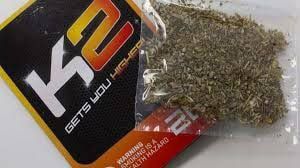Introduction k2 Spray
K2 Spray, a form of synthetic cannabinoid, has garnered significant attention in recent years for its potent effects and controversial usage. Known by various names such as Spice or Synthetic Marijuana, K2 Spray involves applying synthetic cannabinoids to plant material. This guide will delve into the origins, chemical composition, effects, benefits, risks, and legal status of K2 Spray, providing readers with a thorough understanding of this powerful substance.

What is K2 Spray?
K2 Spray is a type of synthetic cannabinoid product that is created by spraying synthetic chemicals onto plant material, which is then smoked or vaporized. These synthetic chemicals are designed to mimic the effects of THC, the primary psychoactive component in cannabis, by binding to the same receptors in the brain. However, K2 Spray often produces effects that are much stronger and less predictable than those of natural cannabis.
History of K2 Spray
The history of K2 Spray is intertwined with the broader history of synthetic cannabinoids. Synthetic cannabinoids were initially developed for research purposes, aiming to explore the potential therapeutic benefits of cannabinoids. However, it wasn’t long before these compounds were adapted for recreational use.
Early Research and Development
In the 1980s and 1990s, researchers studying the endocannabinoid system began developing synthetic cannabinoids. These compounds were intended to help scientists understand how cannabinoids interact with receptors in the brain and body. Dr. John W. Huffman, a chemist at Clemson University, was a key figure in this research, and many synthetic cannabinoids bear his initials (JWH).
Emergence of Recreational Use
By the early 2000s, synthetic cannabinoids began appearing on the recreational drug market. Marketed as “herbal incense” or “potpourri,” these products were sold in head shops and online as a legal alternative to marijuana. Users soon discovered that these products could produce intense psychoactive effects, leading to a surge in popularity and a corresponding increase in health and safety concerns.
Chemical Composition of K2 Spray
K2 Spray is composed of various synthetic cannabinoids, each with its own unique chemical structure. These compounds are designed to interact with the cannabinoid receptors in the brain, specifically CB1 and CB2 receptors. Some of the most common synthetic cannabinoids found in K2 Spray include:
- JWH-018: One of the first synthetic cannabinoids to be widely used, known for its potent effects.
- HU-210: A synthetic cannabinoid much more potent than THC, with long-lasting effects.
- CP 47,497: Initially developed for research purposes, it is another potent synthetic cannabinoid.
The chemical structure of these compounds can vary significantly, leading to a wide range of effects and potential risks.
Effects of K2 Spray
The effects of K2 Spray can be highly unpredictable and vary widely from person to person. While some users report experiences similar to those of natural cannabis, including relaxation and euphoria, the effects of K2 Spray are often much more intense and can be dangerous.
Short-Term Effects
The short-term effects of K2 Spray can include:
- Euphoria: Intense feelings of happiness and well-being.
- Altered Perception: Changes in sensory perception, such as enhanced colors or sounds.
- Relaxation: A deep sense of calm and relaxation.
- Increased Heart Rate: Some users experience a rapid heartbeat, which can be dangerous.
- Paranoia and Anxiety: Negative psychological effects, such as paranoia and anxiety, are common.
Long-Term Effects
The long-term effects of K2 Spray use are not well understood, but there is evidence to suggest that chronic use can lead to serious health problems. Potential long-term effects include:
- Mental Health Issues: Prolonged use has been linked to mental health problems such as depression, anxiety, and psychosis.
- Physical Health Problems: Chronic use can lead to physical health issues, including cardiovascular problems and organ damage.
- Addiction: K2 Spray can be addictive, leading to dependence and withdrawal symptoms.
Benefits of K2 Spray
While the risks associated with K2 Spray are significant, some potential benefits have been explored, primarily in the context of medical research.
Pain Relief
Synthetic cannabinoids have been studied for their potential to relieve pain. Some research suggests that they may be effective in reducing chronic pain, particularly in conditions that are resistant to traditional pain medications.
Appetite Stimulation
Like natural cannabinoids, synthetic cannabinoids may stimulate appetite. This could be beneficial for patients suffering from conditions such as cancer or AIDS, where maintaining a healthy appetite is a challenge.
Risks and Dangers of K2 Spray
The risks and dangers associated with K2 Spray are substantial. Because the chemical composition of K2 Spray can vary widely, the effects are often unpredictable. Some of the most significant risks include:
Acute Toxicity
Numerous reports of acute toxicity have been associated with K2 Spray use. Symptoms of acute toxicity can include:
- Severe Agitation: Users may become extremely agitated and aggressive.
- Seizures: There have been reports of seizures in individuals using K2 Spray.
- Kidney Damage: Acute kidney injury has been reported in some cases.
- Cardiovascular Problems: Increased heart rate and blood pressure can lead to serious cardiovascular problems, including heart attack and stroke.
Mental Health Risks
The psychological effects of K2 Spray can be severe. Users may experience:
- Paranoia: Intense feelings of paranoia and fear.
- Hallucinations: Visual and auditory hallucinations.
- Psychosis: In some cases, K2 Spray use has been linked to episodes of psychosis.
Addiction and Withdrawal
There is evidence to suggest that K2 Spray can be addictive. Users may develop a tolerance to the drug, requiring larger doses to achieve the same effects. Withdrawal symptoms can include:
- Irritability: Users may become irritable and agitated.
- Anxiety: Increased anxiety and nervousness.
- Depression: Feelings of depression and hopelessness.
Legal Status of K2 Spray
The legal status of K2 Spray varies widely around the world. In many countries, synthetic cannabinoids are classified as controlled substances, making their production, sale, and possession illegal. However, because the chemical structure of these compounds can be easily altered, new versions of K2 Spray often emerge that are not covered by existing laws.
United States
In the United States, the federal government has banned several synthetic cannabinoids, including JWH-018 and HU-210. However, new synthetic cannabinoids continue to be developed, and some remain legal under federal law. Many states have also enacted their own bans on synthetic cannabinoids.
Europe
In Europe, synthetic cannabinoids are also controlled substances in many countries. The European Union has taken steps to regulate these substances, but the legal status can vary from one country to another.
Asia
In Asia, the legal status of K2 Spray varies widely. Some countries, such as Japan and South Korea, have banned synthetic cannabinoids, while others have more lenient regulations.
How K2 Spray is Used
K2 Spray is typically used by smoking or vaporizing it. The synthetic cannabinoids are sprayed onto plant material, which is then smoked or vaporized in a similar manner to natural cannabis. Some users also dissolve K2 Spray in a liquid and use it in e-cigarettes or vaporizers.
Smoking
Smoking K2 Spray involves rolling the treated plant material into a cigarette or smoking it in a pipe. The effects are usually felt within minutes and can last for several hours.
Vaporizing
Vaporizing K2 Spray involves using a vaporizer to heat the treated plant material to a temperature at which the synthetic cannabinoids are released as vapor. This method is often preferred because it can produce a more intense effect.
Detection and Testing
Detecting synthetic cannabinoids in the body can be challenging. Standard drug tests, such as those used to detect THC, do not typically detect synthetic cannabinoids. However, specialized tests have been developed to identify the presence of these compounds.
Urine Tests
Urine tests can detect the presence of synthetic cannabinoids for several days after use. These tests are often used in workplace drug testing and by law enforcement.
Blood Tests
Blood tests can detect synthetic cannabinoids for a shorter period, typically within a few hours to a day after use. These tests are often used in clinical settings to diagnose acute toxicity.
Treatment and Recovery
Treating K2 Spray addiction and acute toxicity can be challenging. Because the effects of synthetic cannabinoids can be so unpredictable, there is no standard treatment protocol. However, some general approaches include:
Medical Treatment
In cases of acute toxicity, medical treatment may involve:
- Sedation: To calm agitated or aggressive patients.
- Intravenous Fluids: To treat dehydration and support kidney function.
- Cardiovascular Support: To manage heart rate and blood pressure.
Addiction Treatment
Treating addiction to K2 Spray may involve:
- Behavioral Therapy: Cognitive-behavioral therapy (CBT) can help individuals address the underlying causes of their addiction and develop coping strategies.
- Support Groups: Support groups, such as Narcotics Anonymous, can provide a network of support for individuals in recovery.
Conclusion
K2 Spray, with its potent and unpredictable effects, represents a significant challenge for public health and law enforcement. While it was initially developed for medical research, its repurposing as a recreational drug has led to serious health risks and legal challenges. Understanding the history, chemical composition, effects, benefits, risks, and legal status of K2 Spray is essential for anyone looking to comprehend this complex substance.
As we continue to learn more about synthetic cannabinoids and their impact on the brain and body, it is crucial to approach their use




